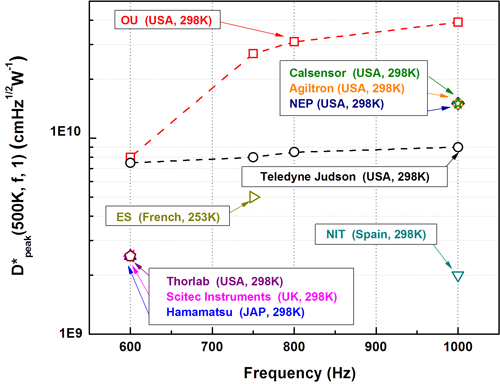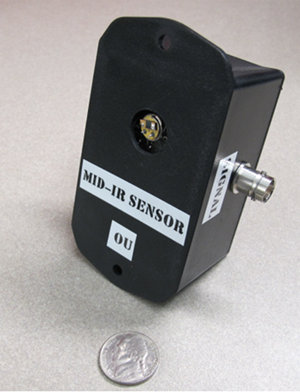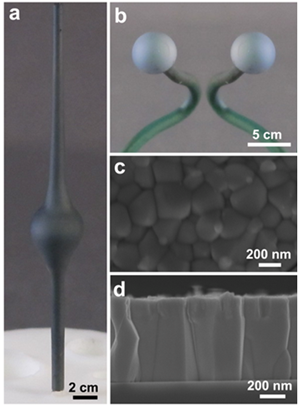
Overview
Main Applications For Uncooled Mid-IR Detectors
Security and Defense Applications
- Man-Portable Weapons Detectors (Sniper, RPGS, Etc.)
- Detectors For Active Protection System
- Low Cost IR Seekers
- Sensor Fuzed Weapons
- Detectors For IR Active Imaging Systems
- Smart Munitions
Industrial Applications
- Industrial Quality Inspection (Glass, Steel, Coal, Etc.)
- Manufacturing Process Control (Laser Welding, Cutting, Control and Characterization)
- Thrusters Combustion Characterization (Jets, Rockets, Etc.)
- Environmental (Gas Detection and Control, Pollution Measurements, Etc.)
- Fire Detection
- Unattended Sensors
- Predictive Maintenance
- Transport
 Currently about 20 companies are selling such detector products. The table on
next page lists major companies involved in Pb-salt detectors. They are all
striking to achieve high D* value.
Currently about 20 companies are selling such detector products. The table on
next page lists major companies involved in Pb-salt detectors. They are all
striking to achieve high D* value.
Recent development by OU optoelectronic group and Nanolight Inc Team
 Partially Sponsored by an OCAST grant, a team of OU opto-electronic group and Nanolight Inc led by
Dr. Shi has recently clarified a nearly century long argument for PbSe PC detector and developed an
optimized fabrication process for Pb-salt uncooled PC detectors. This research leads to record high D* of PbSe
mid-IR PC detector. Figure on the right shows detector performance (D*) of OU PbSe detector in comparisons
with the same type of detectors from commercial companies.
Partially Sponsored by an OCAST grant, a team of OU opto-electronic group and Nanolight Inc led by
Dr. Shi has recently clarified a nearly century long argument for PbSe PC detector and developed an
optimized fabrication process for Pb-salt uncooled PC detectors. This research leads to record high D* of PbSe
mid-IR PC detector. Figure on the right shows detector performance (D*) of OU PbSe detector in comparisons
with the same type of detectors from commercial companies.
 Data from the companies are collected from their published specification sheet.
The group has also successfully developed a prototype PC detector package.
The upper left figure shows one packaged in a TO5,
and the left figure shows a room temperature detector packaged with an amplifier.
Data from the companies are collected from their published specification sheet.
The group has also successfully developed a prototype PC detector package.
The upper left figure shows one packaged in a TO5,
and the left figure shows a room temperature detector packaged with an amplifier.
For further specifications click here.
The Global Market perspectives on uncooled Pb-salt PC detectors
Current companies making or selling Pb-salt uncooled detectors
- Teledyne Judson Technologies
- Agiltron
- Calsensors
- Hamamatsu
- Thorlab
- Newport
- New Infrared Technology
- En’ Urga Inc.
- Pacer USA LLC
- Scitec Instrument Ltd.
- Sciencetech Inc
- Laser Components GmbH
- NKO Ltd (Optico.ru )
- BNN International
- Electro-Optical System Inc
- McPherson Inc
- New England Photoconductor
- Equipements Scientifiques S.A. (Es-france.com)
Related Project
 Inspired by the bio compound eyes, the opto-electronic group at OU led by Dr. Shi is developing a
technology to emulate the insect compound-eyes by using semiconductor micro-size crystal arrays.
The unique nature of IV-VI Pb-salt materials such as PbSe and PbS enables formation of high quality
micro-size crystal arrays on non-planar surface. This enables fabrication of mid-IR detectors on spherical
surface (figure at right) and biomimetic compound eyes detector. fAir Force Office of Scientific
Research has recently awarded one million dollar to Dr. Shi’s group to develop such device.
The optoelectronic group is located at a new OU building with a cleanroom facility.
This state-of-the-art cleanroom facility offers over 3360sq ft of Class 10,000 general
and Class 1000 photo lab cleanroom space. The equipment toolsets provide full turnkey solutions for
ongoing research projects and enable fabrication of advanced electronic and optoelectronic devices using
innovative compound semiconductor materials.
Inspired by the bio compound eyes, the opto-electronic group at OU led by Dr. Shi is developing a
technology to emulate the insect compound-eyes by using semiconductor micro-size crystal arrays.
The unique nature of IV-VI Pb-salt materials such as PbSe and PbS enables formation of high quality
micro-size crystal arrays on non-planar surface. This enables fabrication of mid-IR detectors on spherical
surface (figure at right) and biomimetic compound eyes detector. fAir Force Office of Scientific
Research has recently awarded one million dollar to Dr. Shi’s group to develop such device.
The optoelectronic group is located at a new OU building with a cleanroom facility.
This state-of-the-art cleanroom facility offers over 3360sq ft of Class 10,000 general
and Class 1000 photo lab cleanroom space. The equipment toolsets provide full turnkey solutions for
ongoing research projects and enable fabrication of advanced electronic and optoelectronic devices using
innovative compound semiconductor materials.

